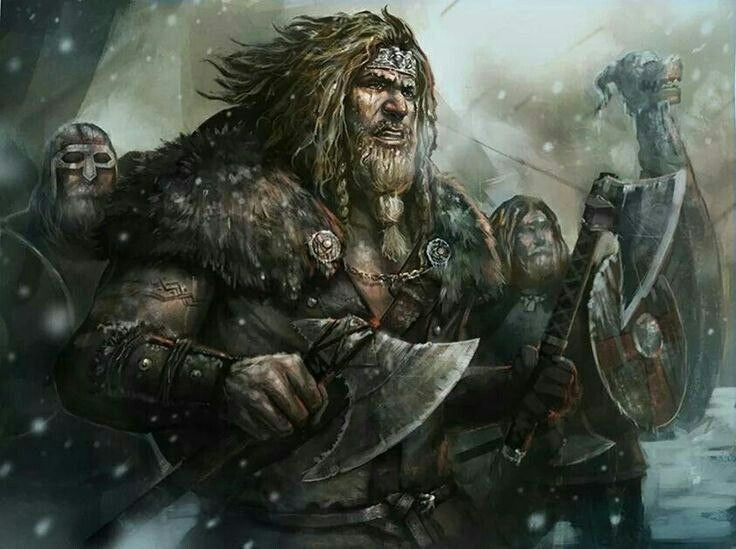The Viking Axe: Symbol of Power, Craftsmanship, and Warfare

The Viking axe is one of the most iconic and recognizable weapons from the Viking Age, symbolizing the strength, skill, and warrior spirit of the Norse people. Unlike swords, which were often the preserve of the wealthy, axes were more commonly used by all classes of Viking society, making them a ubiquitous and versatile tool. Beyond its role as a weapon, the Viking axe was also a vital tool in daily life and a symbol of craftsmanship and heritage.
The Design and Variations of Viking Axes
Viking axes varied in size, design, and purpose, with some crafted for combat and others for everyday tasks such as woodcutting or farming. The most common types of Viking axes include:
-
Bearded Axe (Skeggöx): This type of axe features an extended lower blade that forms a hook or "beard," which allowed for better control and precision in both battle and craftwork. The bearded axe was particularly useful in hooking an enemy's weapon or shield and disarming them in close combat.
-
Broad Axe (Breiðöx): As the name suggests, the broad axe had a wider blade, making it an effective weapon for delivering powerful blows. These axes were often used by Viking warriors in battle, where their broad cutting edge could inflict significant damage.
-
Dane Axe: A two-handed battle axe with a long handle, the Dane axe was used by the elite Viking warriors, known as huscarls. This weapon was known for its reach and the force it could deliver, making it a feared weapon on the battlefield.
-
Throwing Axe (Francisca): While not exclusively Viking in origin, the throwing axe was a popular weapon among Viking warriors. Lightweight and designed for throwing, these axes could be used to disrupt enemy formations before closing in for hand-to-hand combat.
The Axe as a Symbol of Viking Identity
The Viking axe was more than just a weapon; it was a symbol of the Viking identity. In a culture that valued martial prowess and craftsmanship, the axe embodied the ideals of strength, resourcefulness, and independence. Every Viking, from the humblest farmer to the mightiest warrior, owned and relied on an axe, making it a personal and functional extension of themselves.
For the Viking warrior, the axe was a trusted companion in battle. Its design allowed for versatility in combat, enabling the warrior to strike with precision, block incoming blows, or even break through enemy shields. The sight of a Viking warrior wielding a fearsome axe would have struck terror into the hearts of their enemies, reinforcing the image of the Vikings as formidable and relentless fighters.
The craftsmanship involved in making a Viking axe was also a point of pride. Skilled blacksmiths would forge the axe heads with great care, often embellishing them with intricate designs and patterns. The handles, typically made from tough, durable wood like ash or oak, were carefully shaped to ensure a comfortable grip and balance. These axes were not just tools of war but works of art, reflecting the skill and creativity of the Viking craftsman.
The Viking Axe in Daily Life
While the Viking axe is most often associated with warfare, it was also an essential tool in everyday life. Vikings used axes for a variety of tasks, including woodcutting, building ships and houses, and hunting. The same axe that a Viking might carry into battle was likely used to chop firewood or construct a home, highlighting the versatility and importance of this tool in Viking society.
In many ways, the axe was a symbol of self-reliance for the Vikings. The ability to use and maintain an axe was crucial for survival in the harsh Scandinavian environment, where resources were often scarce, and winters were long and brutal. The axe enabled the Vikings to build their settlements, navigate their ships, and defend their homes, making it a cornerstone of their way of life.
The Axe in Viking Burials
The significance of the Viking axe is further underscored by its presence in Viking burials. Archaeological evidence shows that axes were often placed in the graves of Viking warriors, along with other weapons and personal belongings. These burial practices suggest that the axe was seen as an important symbol of the warrior's identity and status, even in death.
In some cases, the axe found in a grave was highly decorated, indicating the wealth and rank of the individual buried. These grave goods served not only as a mark of the deceased's accomplishments in life but also as a means of providing them with the tools they would need in the afterlife.
The Legacy of the Viking Axe
The Viking axe has left a lasting legacy, both in historical memory and modern culture. Today, it is a symbol of Viking strength and heritage, often depicted in films, literature, and popular media. The image of a Viking warrior wielding an axe is instantly recognizable, embodying the courage and resilience that the Vikings are remembered for.
In modern times, the craftsmanship of Viking-style axes has seen a resurgence, with blacksmiths and artisans creating replicas and inspired designs that pay homage to the original tools. These axes are valued not only for their historical significance but also for their functional and artistic qualities.
The Viking axe continues to inspire those who admire the skill, resourcefulness, and warrior spirit of the Norse people. Whether as a tool, weapon, or symbol, the Viking axe remains a powerful reminder of the enduring legacy of the Vikings and their impact on history.
Conclusion
The Viking axe is more than just a weapon; it is a symbol of the Viking spirit. From its role in battle to its importance in daily life, the axe represents the strength, skill, and self-reliance that defined the Norse people. Whether forged for war or crafted for work, the Viking axe remains a timeless emblem of a culture that valued both martial prowess and craftsmanship. As a tool of survival and a symbol of identity, the Viking axe continues to capture the imagination and admiration of people around the world.
Viking axe, Norse mythology, Viking weapons, Skeggöx, Dane axe, Viking craftsmanship, Viking warrior, Viking tools, Viking burial practices, Viking heritage, Viking battle axe.
